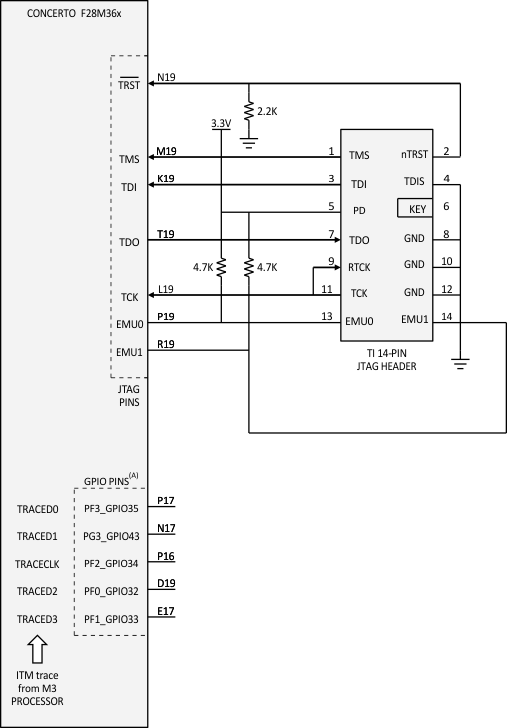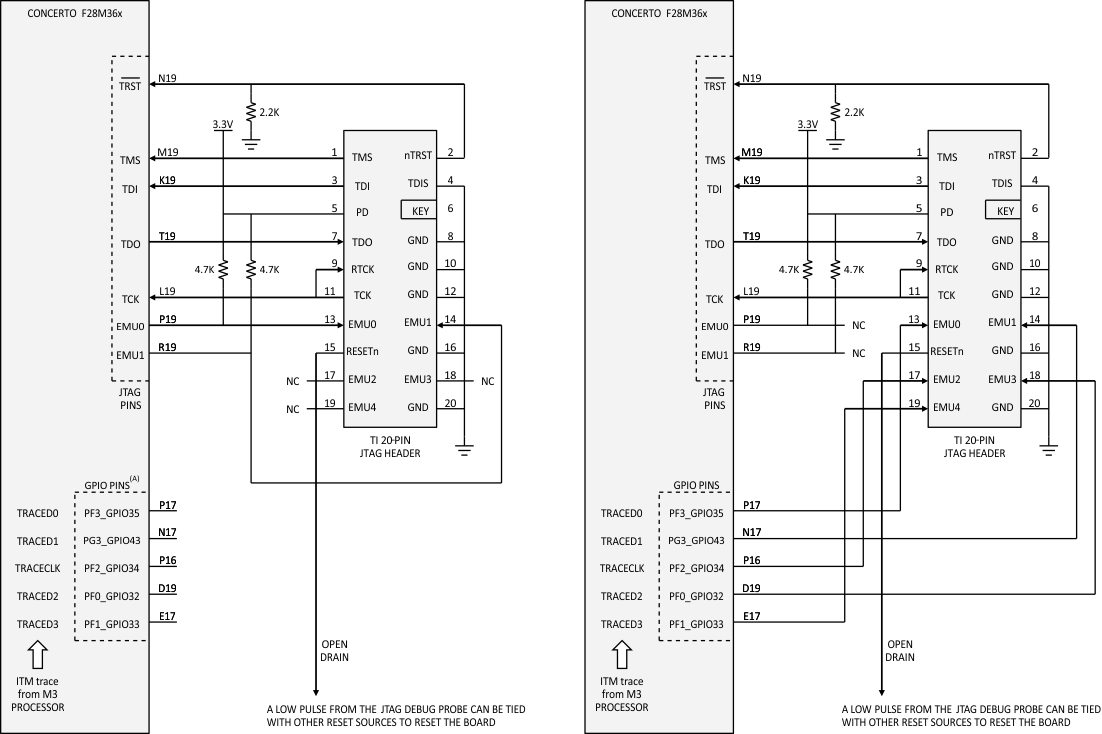SPRS825F October 2012 – June 2020 F28M36H33B2 , F28M36H53B2 , F28M36P53C2 , F28M36P63C2
PRODUCTION DATA.
- 1Device Overview
- 2Revision History
- 3Device Comparison
- 4Terminal Configuration and Functions
-
5Specifications
- 5.1 Absolute Maximum Ratings
- 5.2 ESD Ratings – Commercial
- 5.3 Recommended Operating Conditions
- 5.4 Power Consumption Summary
- 5.5 Electrical Characteristics
- 5.6 Thermal Resistance Characteristics for ZWT Package (Revision 0 Silicon)
- 5.7 Thermal Resistance Characteristics for ZWT Package (Revision A Silicon)
- 5.8 Thermal Design Considerations
- 5.9
Timing and Switching Characteristics
- 5.9.1 Power Sequencing
- 5.9.2
Clock Specifications
- 5.9.2.1 Changing the Frequency of the Main PLL
- 5.9.2.2
Input Clock Frequency and Timing Requirements, PLL Lock Times
- Table 5-5 Input Clock Frequency
- Table 5-7 Crystal Oscillator Electrical Characteristics
- Table 5-8 X1 Timing Requirements - PLL Enabled
- Table 5-9 X1 Timing Requirements - PLL Disabled
- Table 5-10 XCLKIN Timing Requirements - PLL Enabled
- Table 5-11 XCLKIN Timing Requirements - PLL Disabled
- Table 5-12 PLL Lock Times
- 5.9.2.3 Output Clock Frequency and Switching Characteristics
- 5.9.2.4 Internal Clock Frequencies
- 5.9.3 Timing Parameter Symbology
- 5.9.4 Flash Timing – Master Subsystem
- 5.9.5 Flash Timing – Control Subsystem
- 5.9.6 GPIO Electrical Data and Timing
- 5.9.7 External Interrupt Electrical Data and Timing
- 5.10
Analog and Shared Peripherals
- 5.10.1 Analog-to-Digital Converter
- 5.10.2 Comparator + DAC Units
- 5.10.3 Interprocessor Communications
- 5.10.4
External Peripheral Interface
- 5.10.4.1 EPI General-Purpose Mode
- 5.10.4.2 EPI SDRAM Mode
- 5.10.4.3 EPI Host Bus Mode
- 5.10.4.4
EPI Electrical Data and Timing
- Table 5-52 EPI SDRAM Interface Switching Characteristics (see , , and )
- Table 5-53 EPI Host-Bus 8 and Host-Bus 16 Interface Switching Characteristics (see , , , and )
- Table 5-54 EPI Host-Bus 8 and Host-Bus 16 Interface Timing Requirements (see and )
- Table 5-55 EPI General-Purpose Interface Switching Characteristics (see )
- Table 5-56 EPI General-Purpose Interface Timing Requirements (see and )
- 5.11
Master Subsystem Peripherals
- 5.11.1 Synchronous Serial Interface
- 5.11.2 Universal Asynchronous Receiver/Transmitter
- 5.11.3 Cortex-M3 Inter-Integrated Circuit
- 5.11.4 Cortex-M3 Controller Area Network
- 5.11.5 Cortex-M3 Universal Serial Bus Controller
- 5.11.6 Cortex-M3 Ethernet Media Access Controller
- 5.12
Control Subsystem Peripherals
- 5.12.1 High-Resolution PWM and Enhanced PWM Modules
- 5.12.2 Enhanced Capture Module
- 5.12.3 Enhanced Quadrature Encoder Pulse Module
- 5.12.4 C28x Inter-Integrated Circuit Module
- 5.12.5 C28x Serial Communications Interface
- 5.12.6 C28x Serial Peripheral Interface
- 5.12.7
C28x Multichannel Buffered Serial Port
- 5.12.7.1
McBSP Electrical Data and Timing
- 5.12.7.1.1 McBSP Transmit and Receive Timing
- 5.12.7.1.2
McBSP as SPI Master or Slave Timing
- Table 5-81 McBSP as SPI Master or Slave Timing Requirements (CLKSTP = 10b, CLKXP = 0)
- Table 5-82 McBSP as SPI Master or Slave Switching Characteristics (CLKSTP = 10b, CLKXP = 0)
- Table 5-83 McBSP as SPI Master or Slave Timing Requirements (CLKSTP = 11b, CLKXP = 0)
- Table 5-84 McBSP as SPI Master or Slave Switching Characteristics (CLKSTP = 11b, CLKXP = 0)
- Table 5-85 McBSP as SPI Master or Slave Timing Requirements (CLKSTP = 10b, CLKXP = 1)
- Table 5-86 McBSP as SPI Master or Slave Switching Characteristics (CLKSTP = 10b, CLKXP = 1)
- Table 5-87 McBSP as SPI Master or Slave Timing Requirements (CLKSTP = 11b, CLKXP = 1)
- Table 5-88 McBSP as SPI Master or Slave Switching Characteristics (CLKSTP = 11b, CLKXP = 1)
- 5.12.7.1
McBSP Electrical Data and Timing
-
6Detailed Description
- 6.1 Memory Maps
- 6.2 Identification
- 6.3 Master Subsystem
- 6.4 Control Subsystem
- 6.5 Analog Subsystem
- 6.6 Master Subsystem NMIs
- 6.7 Control Subsystem NMIs
- 6.8 Resets
- 6.9 Internal Voltage Regulation and Power-On-Reset Functionality
- 6.10 Input Clocks and PLLs
- 6.11 Master Subsystem Clocking
- 6.12 Control Subsystem Clocking
- 6.13 Analog Subsystem Clocking
- 6.14 Shared Resources Clocking
- 6.15 Loss of Input Clock (NMI Watchdog Function)
- 6.16 GPIOs and Other Pins
- 6.17 Emulation/JTAG
- 6.18 Code Security Module
- 6.19 µCRC Module
- 7Applications, Implementation, and Layout
- 8Device and Documentation Support
- 9Mechanical, Packaging, and Orderable Information
Package Options
Mechanical Data (Package|Pins)
- ZWT|289
Thermal pad, mechanical data (Package|Pins)
Orderable Information
6.17 Emulation/JTAG
Concerto devices have two types of emulation ports to support debug operations: the 7-pin TI JTAG port and the 5-pin Cortex-M3 Instrumentation Trace Macrocell (ITM) port. The 7-pin TI JTAG port can be used to connect to debug tools through the TI 14-pin JTAG header or the TI 20-pin JTAG header. The 5-pin Cortex-M3 ITM port can only be accessed through the TI 20-pin JTAG header.
The JTAG port has seven dedicated pins: TRST, TMS, TDI, TDO, TCK, EMU0, and EMU1. The TRST signal should always be pulled down through a 2.2-kΩ pulldown resistor on the board. EMU0 and EMU1 signals should be pulled up through a pair of pullups ranging from 2.2 kΩ to 4.7 kΩ (depending on the drive strength of the debugger ports). The JTAG port is TI’s standard debug port.
The ITM port uses five GPIO pins that can be mapped to internal Cortex-M3 ITM trace signals: TRACE0, TRACE1, TRACE2, TRACE3, and TRACECLK. This port is typically used for advanced software debug.
TI JTAG debug probes, and those from other manufacturers, can connect to Concerto devices through TI’s 14-pin JTAG header or 20-pin JTAG header. See Figure 6-18 to see how the 14-pin JTAG header connects to the JTAG port signals in Concerto. The 14-pin header does not support the ITM debug mode.
Figure 6-19 shows two possible ways to connect the 20-pin header to the emulation pins in Concerto. The left side of the drawing shows all seven JTAG signals connecting to the 20-pin header similar to the way the 14-pin header was connected. The JTAG EMU0 and EMU1 signals are mapped to the corresponding terminals on the 20-pin header. In this mode, header terminals EMU2, EMU3, and EMU4 are left unconnected and the ITM trace mode is not available.
The right side of the drawing shows the same 20-pin header now connected to five ITM signals and five of seven JTAG signals. The EMU0 and EMU1 signals in Concerto are left unconnected in this mode; thus, the emulation functions associated with these two signals are not available when debugging with ITM trace.

